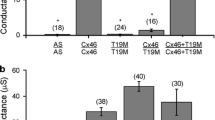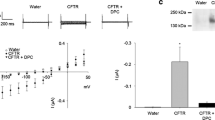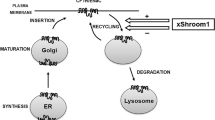Abstract
The C-terminus (CT) of rCx46 consists of 186 residues (H230-I416). Recent studies showed that rCx4628.2, truncated after H243, altered the formation of functional hemichannels when expressed in Xenopus oocytes, while rCx4637.7, truncated after A333 formed gap junction hemichannels similarly to rCx46wt. To analyze the role of the CT up to A333 in functional expression with cell imaging and dye-transfer techniques, different mutants were generated by C-terminal truncation between H243-A333, labeled with EGFP and expressed in HeLa cells. These rCx46 variants were characterized according to their compartmentalization in organelles, their presence in microscopic detectable vesicles and their ability to form gap junction plaques. rCx46 truncated after A311 (rCx4635.3) was compartmentalized, was found in vesicles and formed functional gap junction plaques similarly to rCx46wt. With a truncation after P284 (rCx4632.6), the protein was not compartmentalized and the amount of vesicles containing the protein were reduced; however, functional gap junction plaque formation was not affected as compared to rCx4635.3. rCx4628.2 did not form functional gap junction plaques; it was not found in vesicles or in cellular compartments. Live-cell imaging and detection of annular junctions for rCx4632.6 and rCx4635.3 revealed that the truncation after P284 reduced the frequency of vesicle budding from gap junction plaques and the formation of annular junctions. These results suggest that the C-terminal region of rCx46 up to A311 (rCx4635.3) is necessary for its correct compartmentalization and internalization in the form of annular junctions, while the H230-P284 C-terminal region (rCx4632.6) is sufficient for the formation of dye coupled gap junction channels.
Similar content being viewed by others
References
Abraham V, Chou ML, DeBolt KM, Koval M (1999) Phenotypic control of gap junctional communication by cultured alveolar epithelial cells. Am J Physiol 276:L825–L834
Akiyama M, Ishida N, Ogawa T, Yogo K, Takeya T (2005) Molecular cloning and functional analysis of a novel Cx43 partner protein CIP150. Biochem Biophys Res Commun 335:1264–1271
Avanzo JL, Mesnil M, Hernandez-Blazquez FJ, da Silva TC, Fukumasu H, Mori CM, Yamasaki H, Dagli ML (2006) Altered expression of connexins in urethane-induced mouse lung adenomas. Life Sci 79:2202–2208
Banerjee D, Gakhar G, Madgwick D, Hurt A, Takemoto D, Nguyen TA (2010) A novel role of gap junction connexin46 protein to protect breast tumors from hypoxia. Int J Cancer 127:839–848
Berthoud VM, Beyer EC (2009) Oxidative stress, lens gap junctions, and cataracts. Antioxid Redox Signal 11:339–353
Berthoud VM, Minogue PJ, Laing JG, Beyer EC (2004) Pathways for degradation of connexins and gap junctions. Cardiovasc Res 62:256–267
Chai Z, Goodenough DA, Paul DL (2011) Cx50 requires an intact PDZ-binding motif and ZO-1 for the formation of functional intercellular channels. Mol Biol Cell 22:4503–4512
Chandross KJ (1998) Nerve injury and inflammatory cytokines modulate gap junctions in the peripheral nervous system. Glia 24:21–31
Das S, Smith TD, Sarma JD, Ritzenthaler JD, Maza J, Kaplan BE, Cunningham LA, Suaud L, Hubbard MJ, Rubenstein RC, Koval M (2009) ERp29 restricts Connexin43 oligomerization in the endoplasmic reticulum. Mol Biol Cell 20:2593–2604
Das Sarma J, Kaplan BE, Willemsen D, Koval M (2008) Identification of rab20 as a potential regulator of connexin 43 trafficking. Cell Commun Adhes 15:65–74
Dbouk HA, Mroue RM, El-Sabban ME, Talhouk RS (2009) Connexins: a myriad of functions extending beyond assembly of gap junction channels. Cell Commun Signal 7:4
discussion 54–59
Falk MM, Kumar NM, Gilula NB (1994) Membrane insertion of gap junction connexins: polytopic channel forming membrane proteins. J Cell Biol 127:343–355
Falk MM, Baker SM, Gumpert AM, Segretain D, Buckheit RW 3rd (2009) Gap junction turnover is achieved by the internalization of small endocytic double-membrane vesicles. Mol Biol Cell 20:3342–3352
Giepmans BN, Moolenaar WH (1998) The gap junction protein connexin43 interacts with the second PDZ domain of the zonula occludens-1 protein. Curr Biol 8:931–934
Ginzberg RD, Gilula NB (1979) Modulation of cell junctions during differentiation of the chicken otocyst sensory epithelium. Dev Biol 68:110–129
Hervé JC, Bourmeyster N, Sarrouilhe D, Duffy HS (2007) Gap junctional complexes: from partners to functions. Prog Biophys Mol Biol 94:29–65
Jin C, Lau AF, Martyn KD (2000) Identification of connexin-interacting proteins: application of the yeast two-hybrid screen. Methods 20:219–231
Jordan K, Solan JL, Dominguez M, Sia M, Hand A, Lampe PD, Laird DW (1999) Trafficking, assembly, and function of a connexin43-green fluorescent protein chimera in live mammalian cells. Mol Biol Cell 10:2033–2050
Jordan K, Chodock R, Hand AR, Laird DW (2001) The origin of annular junctions: a mechanism of gap junction internalization. J Cell Sci 114:763–773
Koval M (2006) Pathways and control of connexin oligomerization. Trends Cell Biol 16:159–166
Koval M, Harley JE, Hick E, Steinberg TH (1997) Connexin46 is retained as monomers in a trans-Golgi compartment of osteoblastic cells. J Cell Biol 137:847–857
Laird DW (2010) The gap junction proteome and its relationship to disease. Trends Cell Biol 20:92–101
Laird DW (2006) Life cycle of connexins in health and disease. Biochem J 394:527–543
Lampe PD, Lau AF (2000) Regulation of gap junctions by phosphorylation of connexins. Arch Biochem Biophys 384:205–215
Lampe PD, Lau AF (2004) The effects of connexin phosphorylation on gap junctional communication. Int J Biochem Cell Biol 36:1171–1186
Lan Z, Kurata WE, Martyn KD, Jin C, Lau AF (2005) Novel rab GAP-like protein, CIP85, interacts with connexin43 and induces its degradation. Biochemistry 44:2385–2396
Larsen WJ, Tung HN, Murray SA, Swenson CA (1979) Evidence for the participation of actin microfilaments and bristle coats in the internalization of gap junction membrane. J Cell Biol 83:576–587
Leykauf K, Salek M, Bomke J, Frech M, Lehmann WD, Durst M, Alonso A (2006) Ubiquitin protein ligase Nedd4 binds to connexin43 by a phosphorylation-modulated process. J Cell Sci 119:3634–3642
Majoul IV, Onichtchouk D, Butkevich E, Wenzel D, Chailakhyan LM, Duden R (2009) Limiting transport steps and novel interactions of Connexin-43 along the secretory pathway. Histochem Cell Biol 132:263–280
Martin PE, Steggles J, Wilson C, Ahmad S, Evans WH (2000) Targeting motifs and functional parameters governing the assembly of connexins into gap junctions. Biochem J 350(Pt 3):943
Martin PE, Blundell G, Ahmad S, Errington RJ, Evans WH (2001) Multiple pathways in the trafficking and assembly of connexin 26, 32 and 43 into gap junction intercellular communication channels. J Cell Sci 114:3845–3855
Mazet F, Wittenberg BA, Spray DC (1985) Fate of intercellular junctions in isolated adult rat cardiac cells. Circ Res 56:195–204
Minogue PJ, Liu X, Ebihara L, Beyer EC, Berthoud VM (2005) An aberrant sequence in a connexin46 mutant underlies congenital cataracts. J Biol Chem 280:40788–44095
Murray SA, Nickel BM, Gay VL (2004) Endocytosis of connexin protein in adrenal cells. Endocr Res 30:647–654
Musil LS, Goodenough DA (1991) Biochemical analysis of connexin43 intracellular transport, phosphorylation, and assembly into gap junctional plaques. J Cell Biol 115:1357–1374
Ngezahayo A, Zeilinger C, Todt I, Marten I, Kolb HA (1998) Inactivation of expressed and conducting rCx46 hemichannels by phosphorylation. Pflugers Arch 436:627–629
Nickel BM, DeFranco BH, Gay VL, Murray SA (2008) Clathrin and Cx43 gap junction plaque endoexocytosis. Biochem Biophys Res Commun 374:679–682
Nielsen PA, Baruch A, Giepmans BN, Kumar NM (2001) Characterization of the association of connexins and ZO-1 in the lens. Cell Commun Adhes 8:213–217
Nielsen PA, Baruch A, Shestopalov VI, Giepmans BN, Dunia I, Benedetti EL, Kumar NM (2003) Lens connexins alpha3Cx46 and alpha8Cx50 interact with zonula occludens protein-1 (ZO-1). Mol Biol Cell 14:2470–2481
Paul DL, Ebihara L, Takemoto LJ, Swenson KI, Goodenough DA (1991) Connexin46, a novel lens gap junction protein, induces voltage-gated currents in nonjunctional plasma membrane of Xenopus oocytes. J Cell Biol 115:1077–1089
Qu C, Gardner P, Schrijver I (2009) The role of the cytoskeleton in the formation of gap junctions by Connexin 30. Exp Cell Res 315:1683–1692
Salameh A (2006) Life cycle of connexins: regulation of connexin synthesis and degradation. Adv Cardiol 42:57–70
Schubert AL, Schubert W, Spray DC, Lisanti MP (2002) Connexin family members target to lipid raft domains and interact with caveolin-1. Biochemistry 41:5754–5764
Segretain D, Falk MM (2004) Regulation of connexin biosynthesis, assembly, gap junction formation, and removal. Biochim Biophys Acta 1662:3–21
Shaw RM, Fay AJ, Puthenveedu MA, von Zastrow M, Jan YN, Jan LY (2007) Microtubule plus-end-tracking proteins target gap junctions directly from the cell interior to adherens junctions. Cell 128:547–560
Silver RB, Kriebel ME, Keller B, Pappas GD (2003) Porocytosis: secretion from small and medium-diameter vesicles and vesicle arrays without membrane fusion. J Neurocytol 32:277–291
Sohl G, Willecke K (2004) Gap junctions and the connexin protein family. Cardiovasc Res 62:228–232
Thomas MA, Zosso N, Scerri I, Demaurex N, Chanson M, Staub O (2003) A tyrosine-based sorting signal is involved in connexin43 stability and gap junction turnover. J Cell Sci 116:2213–2222
Unwin PN, Zampighi G (1980) Structure of the junction between communicating cells. Nature 283:545–549
Walter WJ, Zeilinger C, Bintig W, Kolb HA, Ngezahayo A (2008) Phosphorylation in the C-terminus of the rat connexin46 (rCx46) and regulation of the conducting activity of the formed connexons. J Bioenerg Biomembr 40:397–405
Wayakanon P, Bhattacharjee R, Nakahama K, Morita I (2012) The role of the Cx43 C-terminus in GJ plaque formation and internalization. Biochem Biophys Res Commun 420:456–461
Wei CJ, Francis R, Xu X, Lo CW (2005) Connexin43 associated with an N-cadherin-containing multiprotein complex is required for gap junction formation in NIH3T3 cells. J Biol Chem 280:19925–19936
White TW, Bruzzone R (1996) Multiple connexin proteins in single intercellular channels: connexin compatibility and functional consequences. J Bioenerg Biomembr 28:339–350
Yeager M, Unger VM, Falk MM (1998) Synthesis, assembly and structure of gap junction intercellular channels. Curr Opin Struct Biol 8:517–524
Zampighi GA, Planells AM, Lin D, Takemoto D (2005) Regulation of lens cell-to-cell communication by activation of PKCgamma and disassembly of Cx50 channels. Invest Ophthalmol Vis Sci 46:3247–3255
Zhang JT, Chen M, Foote CI, Nicholson BJ (1996) Membrane integration of in vitro-translated gap junctional proteins: co- and post-translational mechanisms. Mol Biol Cell 7:471–482
Author information
Authors and Affiliations
Corresponding author
Electronic supplementary material
Below is the link to the electronic supplementary material.
(AVI 2183 kb)
Rights and permissions
About this article
Cite this article
Schlingmann, B., Schadzek, P., Hemmerling, F. et al. The role of the C-terminus in functional expression and internalization of rat connexin46 (rCx46). J Bioenerg Biomembr 45, 59–70 (2013). https://doi.org/10.1007/s10863-012-9480-x
Received:
Accepted:
Published:
Issue Date:
DOI: https://doi.org/10.1007/s10863-012-9480-x




